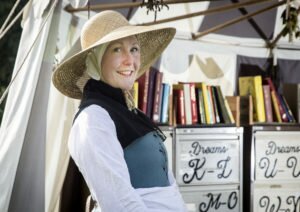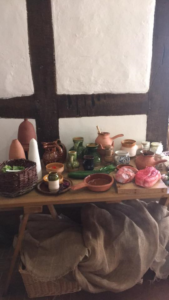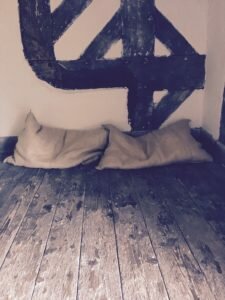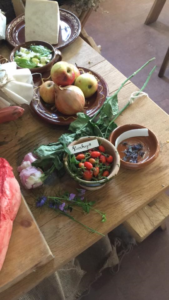Warm posset anyone? In this BBC Ideas video, historian Professor Sasha Handley shares five top tips from the past, that could help you sleep better. Made in association with the British Academy.
Category: Blog Posts
Our Year Looking at How We Used to Sleep
 As we’ve reached the end of our year-long project, ‘How We Used to Sleep’, it seems like a good time to take stock of what we have achieved at Little Moreton Hall. The aim of our events and activities was to translate Dr Sasha Handley’s research into early modern sleep into an engaging range of activities, events, talks, training and educational materials for our staff and for the wider public. We wanted to see if we could spend some time in the shoes (or bedclothes) of the people who lived at Little Moreton Hall in the sixteenth and seventeenth centuries, to see if we could understand more about what they believed and the practices they followed and whether we could actually pick up some good tips about how to live well and sleep better. Continue reading “Our Year Looking at How We Used to Sleep”
As we’ve reached the end of our year-long project, ‘How We Used to Sleep’, it seems like a good time to take stock of what we have achieved at Little Moreton Hall. The aim of our events and activities was to translate Dr Sasha Handley’s research into early modern sleep into an engaging range of activities, events, talks, training and educational materials for our staff and for the wider public. We wanted to see if we could spend some time in the shoes (or bedclothes) of the people who lived at Little Moreton Hall in the sixteenth and seventeenth centuries, to see if we could understand more about what they believed and the practices they followed and whether we could actually pick up some good tips about how to live well and sleep better. Continue reading “Our Year Looking at How We Used to Sleep”
Things That Go Bump In The Night
As Halloween approaches, here at histories of sleep we’re thinking about things that go bump in the night – specifically in the early modern period!
What caused early modern people to fear the onset of sleep? And why did they go to great lengths to protect themselves from the negative forces that might infiltrate their slumber? How did they protect themselves? To answer these questions it is first important to remember that sleep was not, and indeed still isn’t, merely a biological necessity. The way that early modern people understood sleep was very much prescribed and shaped by the culture that they inhabited. Close associations between sleep and death, between night-time and diabolical phenomenon, and between material objects and spiritual protection all contributed to early modern understandings of the nature of sleep and the fears and anxieties surrounding its approach. As A. Roger Ekirch has argued, night-time in this period ‘embodied a distinct culture, with many of its own customs and rituals’.[1] Continue reading “Things That Go Bump In The Night”
Harvesting and Hibernation: Sleeping Through the Winter

Eating the right kinds of food at the right times of day formed an important part of early modern sleep-management techniques. Contemporary advice also points us in the direction of certain foods that can help make you feel sleepy and these foods share some common ground with early modern diets, as our previous post outlined [click here]. So, as the team at Little Moreton Hall have turned their attention to food preservation this autumn, we thought we’d share some information about what the Hall’s residents stocked up on to ensure they slept well over the winter. Continue reading “Harvesting and Hibernation: Sleeping Through the Winter”
Hard Work and Sweet Slumber on Radio 4’s ‘Start the Week’

Sleep and the question of whether, as a society, we are getting enough is becoming increasingly topical. In fact, even during our project this year we have seen a whole range of articles, programmes, books and discussions on the issue. Radio 4’s Start the Week looked at sleep and society this week by talking to our very own Dr Sasha Handley from the University of Manchester alongside Professor Matthew Walker from The Center for Human Sleep Science at the University of California, Susan Foister from the National Gallery in London and Matthew Taylor from the Royal Society for the Encouragement of Arts, Manufacture and Commerce. Continue reading “Hard Work and Sweet Slumber on Radio 4’s ‘Start the Week’”
Top Sleep Tips for Children

One of the motivations for the How We Used to Sleep project was the ongoing ‘global sleep crisis’ we are currently experiencing. In our 24/7, always connected, constantly illuminated western culture, many of us are guilty of neglecting sleep or of not devoting much thought to how we might sleep better. We have heard the voices of neuroscientists, governmental agencies and medical professionals, often with mixed results, but what can historians add to this conversation? What can early modern people teach us about how to sleep well? Continue reading “Top Sleep Tips for Children”
Little Moreton Hall’s Sleep Remedies
Visitors to Little Moreton Hall have been helping us prepare our sleep remedies over the past month, stocking up our still room with lots of different ingredients from our sleep bed and seeing what they think of some of our tips for getting a good night’s sleep Tudor-style. There are no surviving recipe books from the Moreton family who lived at the hall but they may well have used similar remedies to those that follow, which date to the same period. Try them for yourself and see which, if any, work for you. Our remedies have been taken from 16th and early 17th century housewifery and medical manuals and personal handwritten recipe books from the Wellcome Trust’s collection, which are digitised and available online.[1] Continue reading “Little Moreton Hall’s Sleep Remedies”
The Truth About Sleep? We’ve Known How to Get a Better Night’s Sleep for Centuries!
Want to find out if you’re sleep deprived? Try out the sleep onset latency test!
Last week I sat down to watch a BBC documentary that focused on a theme that I’ve been quietly obsessing about for the last few months: sleep. Or more accurately – how to get a better night’s sleep. The programme followed the genial Dr Michael Mosley as he attempted to discover the ‘truth about sleep’ in a bid to overcome his own sleep problems. As Mosley dejectedly explained to the viewer, he suffered from insomnia and was ready to become a human lab rat in order to cure himself of the condition. Mosley talked to a variety of scientists and sleep experts that confirmed how detrimental sleep loss can be for a person’s health and well-being. Not only can it lead to irritability and loss of productivity, new studies are also showing that sleep deprivation could be an underlying cause of the obesity crisis and the explosion of people suffering from type 2 diabetes.[1]
Early Modern Soporifics
A couple of weeks ago, with the help of our friends and colleagues at Carter House Day Centre and Cheshire East council, we completed the initial planting of our early modern sleep bed at Little Moreton Hall. The sleep bed was carefully designed by the service users at Carter House Day Centre. As well as being instrumental in the conception and installation of the sleep bed, they will also be producing their own mini replica of the garden back at Carter House. From lavender and roses, to poppies and violets, we planted an array of herbs, flowers, and shrubs that early modern people believed aided sleep. But what was it about these plants that convinced the people of the sixteenth, seventeenth, and eighteenth centuries that they would help their pursuit of a sound night’s sleep? In this post we explore some of the ideas behind these soporific ingredients and the ways in which they were used to treat early modern sleep loss. Continue reading “Early Modern Soporifics”
Early Modern Tips for a Good Night’s Sleep
To round off Sleep Awareness Week we are thinking about what we in the 21st century can learn from early modern approaches to sleep.
Recently sleep, or more accurately the lack of sleep, has been making headlines. From LinkedIn explaining the importance of a good night’s sleep for your career, to BBC Panorama investigating the chronic sleep deprivation of British children, to the launch of apps that promise to improve your sleep by reducing blue light emissions from your mobile devices, sleep management is now a hot topic. Why? Well as statistics show, the United Kingdom is one of the most sleep-deprived nations in Europe. According to research firm, Rand Europe, who used data from around 62,000 people, sleep loss costs the British economy around £40bn a year through lost productivity. Even more worryingly, British workers who sleep less than six hours a night are 13% more likely to die earlier than those getting between seven and nine hours.[1] The picture looks equally bleak for the UK’s toddlers and teenagers. NHS data that has been analysed by BBC Panorama shows that hospital attendances for children under the age of 14 suffering from sleep disorders has tripled in the last decade, whilst the number of prescriptions for melatonin, the chemical that helps you feel sleepy, have also increased dramatically.[2] According to the Children’s Sleep Charity, sleep problems are costing the NHS unnecessary millions in needless GP and paediatrician appointments and prescriptions. The charity suggests that the solution to the nation’s sleep problems lies not in medication, but in an overhaul of our bedtime routines.[3] Continue reading “Early Modern Tips for a Good Night’s Sleep”
